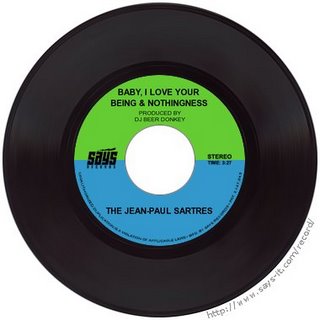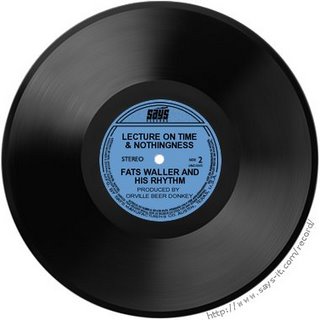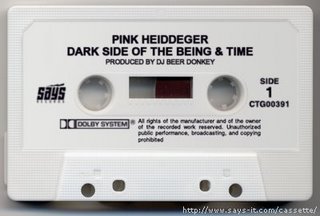
After 15 months of intense preparation, I was ready to launch a triple-threat blog post today on Jean-Paul Sartre's Being & Nothingness, Martin Heidegger's Being & Time, and Thomas Wright Waller's Time & Nothingness, but then Liam went and declared this Official Silly Blogging Day, so all of my research (including an interview with the last remaining existentialist in the Northern Hemisphere, one Mrs. Humphrey Dingledorff, 93, of Chastise, Mo.) went out the window, the window of opportunity only open between 8:37 am this morning and 6:14 this evening. Thanks a lot, Liam.
But out of deference to Liam, and because I think he's on to something serious with Official Silly Blogging Day, and because I want to use all the cool "Generate-your-own-sign" things he led me to on his blog, I'll abandon my 15-month research project and adapt to the present situation.
What I can offer is a kind of abbreviated analysis of these three historical and life-changing tomes:
1) Being & Nothingness - Jean-Paul's version of To Be or Not To Be rocks. Or at least that's what I've heard. I haven't actually read it yet. But I was going to. Really.

2) Being & Time - Marty's masterpiece is a fairly thick paperback, if I may say so myself. It's right there on the shelf, between The Raymond Chandler Omnibus and Julio Cortázar's Around the Day in 80 Worlds, which is a wonderful book that my wife picked up for me at the Strand Bookstore in New York on her way back to Madrid several years ago. Cortázar seriously rocked. Really. Especially Cronopios and Famas. And Blow-Up, of course, which Antonioni made into a film in the 1960s that was in English and had some British dude in it, even though the story was written by an Argentine who lived in
3) Time & Nothingness - I’m on a little firmer ground here. The famous 20th century American philosopher Thomas Wright Waller (better known as “Fats” Waller) gave the world this classic work (better known as “Loafin’ Time) in 1935, at the height of, uh, well, the 1930s. He takes a penetrating look at time and its complex relationship to nothingness. He confronts these two themes head-on, as it were. Part spiritual tract, part philosophical meditation, and part swing masterpiece. He lays it on the line for us:
I just love this lazy way of living
Honey, don't you know, doing nothing ain't no sin
If it is, I hope that I'm forgiven
'Cause I've got nothing to do and I've got all day to do it in. That’s pretty much it in a nutshell, isn’t it? Doing nothing is NOT a sin. (Notice the skillful use of the triple negative.) But if it IS a sin (notice how he shows doubt and certainty at the same time), I hope that G-d, in his infinite mercy and love of swing jazz, offers me forgiveness. What is jazz all about in the end if it isn’t about time? How time can stretch and bend and generally be more fluid in than we’re normally accustomed to in our everyday lives. Jazz says, “Be-bop, re-bop,” which we can interpret as, “Slow down, buddy, and smell the roses.” Connections here to Taoism and Buddhism. Life is going by pretty fast, but if you enter jazz (i.e., spiritual living), you can move at a different pace and observe things more closely. You can live in harmony with everything around you, which is all interconnected anyway and gets tangled up in your pajama legs at night. It’s not a sin if you sit on your G-d given derriere and listen to Fats Waller. Or better, if you turn out the lights and lay on the floor with someone you love and listen to Lester Young playing “Blue Lester.” Think I’m joking? Charles Simic, one of our greatest contemporary American poets commented on this phenomenon in his personal notebook:
That’s pretty much it in a nutshell, isn’t it? Doing nothing is NOT a sin. (Notice the skillful use of the triple negative.) But if it IS a sin (notice how he shows doubt and certainty at the same time), I hope that G-d, in his infinite mercy and love of swing jazz, offers me forgiveness. What is jazz all about in the end if it isn’t about time? How time can stretch and bend and generally be more fluid in than we’re normally accustomed to in our everyday lives. Jazz says, “Be-bop, re-bop,” which we can interpret as, “Slow down, buddy, and smell the roses.” Connections here to Taoism and Buddhism. Life is going by pretty fast, but if you enter jazz (i.e., spiritual living), you can move at a different pace and observe things more closely. You can live in harmony with everything around you, which is all interconnected anyway and gets tangled up in your pajama legs at night. It’s not a sin if you sit on your G-d given derriere and listen to Fats Waller. Or better, if you turn out the lights and lay on the floor with someone you love and listen to Lester Young playing “Blue Lester.” Think I’m joking? Charles Simic, one of our greatest contemporary American poets commented on this phenomenon in his personal notebook:
The recording of “Blue Lester,” which lasts 3 minutes and 22 seconds in our limited space-time world, seemed to last forever. Because it does. Lester is still playing his tenor saxophone, and Fats Waller is still singing “I’ve got nothing to do and I’ve got all day to do it in,” and Cortázar is still writing his beautifully funny stories, and Siddartha Gautama’s still sitting under his tree, and I’m still writing this silly entry on Official Silly Blogging Day and will be even after I stop.























1 comment:
Great post. Mrs. Dingledorf is surprising hot for her age.
Post a Comment